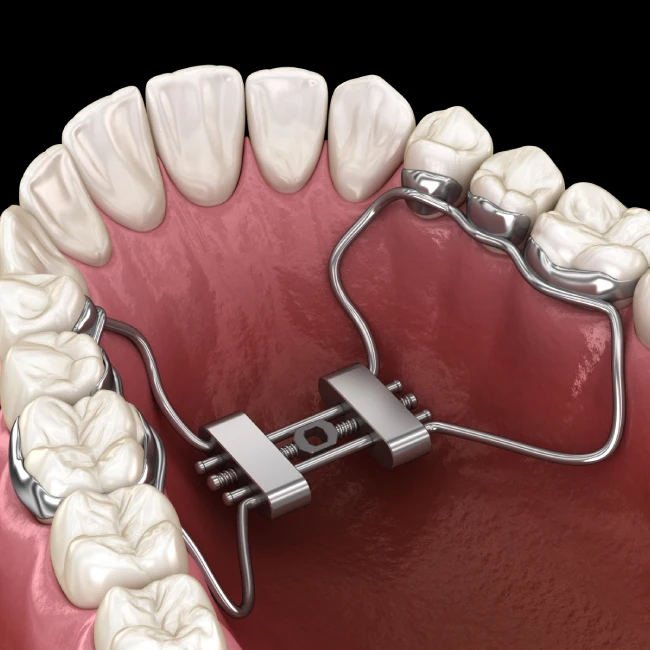Hamilton Orthodontics
Rapid Palatal Expander
Why an RPE?
During an examination, our orthodontist will evaluate how the upper and lower teeth bite together. When the upper teeth are on the inside of the lower teeth in the back sections of the mouth, it is called a posterior crossbite. If the posterior crossbite is only on one side, it can cause the lower jaw to grow asymmetrically, or unevenly to that side. RPE appliances are often used to correct posterior crossbites to prevent asymmetrical growth of the lower jaw and to obtain more room for the other unerupted teeth.
We correct posterior crossbites as soon as we see them because it is better to do this procedure at a younger age before the palatal suture becomes fused.
With adults, the upper jaw can be expanded by using an RPE and having surgery performed by an oral surgeon. This procedure is called Surgically Assisted Rapid Palatal Expander (SARPE).

Cleaing RPE
Turning RPE
How to activate the RPE.
The activation of an RPE is usually done by a parent, guardian or other household member. The patient is given a small wrench that fits over the screw of the RPE appliance. The patient tilts their head back and opens very wide so that the RPE can be seen clearly. Holding the wrench securely with two fingers it is placed on the screw of the RPE as close to the upper teeth as possible. The wrench is then rotated towards the bottom front teeth. After one “swing” of the wrench, it is carefully removed without turning the screw backwards and a second “swing” of the wrench is completed. Two “swings” of the wrench is considered one activation. Our orthodontic team will provide detailed instructions about when and how to activate the RPE once it is placed. Usually a patient will activate the expander once or twice a day for a prescribed number of days. Once the RPE is placed regular follow up visits are scheduled to closely monitor the progress of the expansion.
How long is RPE treatment?
Response to orthoodontic treatment can vary with every patient. The amount of time a patient requires for RPE treatment varies with the amount of expansion desired and their response to the appliance. Typically the RPE activation phase is three weeks. Once the desired expansion is achieved the RPE remains in place without activation, or turning, for about six months. This non-activation time is required to allow the palatal suture to solidify with new bone growth and the expansion of the palate bones to become stable. If the RPE is removed early, some of the width or expansion gained could be lost. During the expansion, a space may develop between the central incisors or two front teeth. This is normal. When the activation phase of the RPE treatment is completed, the gum tissue between the front teeth will pull the teeth closer together and possibly eliminate this new space. If not, any space that remains will be closed at the completion of treatment.
Questions our Patients may have regarding RPE treatment.
How does it feel to wear an RPE appliance?
It will likely take 3-5 days to get used to having the rapid palatal expander appliance in your mouth. Wearing an RPE does not hurt. After you turn the expander with the wrench you will feel pressure. The pressure lasts for about 4 to 5 minutes and feels like you are pushing on your teeth with your thumb.
Certain speech sounds may be difficult for you to say at first, such as “th” and “s” sounds. This will improve with time. Speaking, singing and reading out loud can be vey helpful. You will feel like you have extra saliva in your mouth when you first get your expander appliance. Your brain automatically starts saliva production when you put something in your mouth, even if it isn’t food. It can take a few days to get used to swallowing but carring a water bottle and practicing by taking small, frequent sips of water will help. Try not to rub your tongue and cheeks on the expander as your mouth tissues can become irritated and sore. If this happens you can try rinsing with warm salt water for a few days. Placing dental wax on the RPE opposite a sore spot may also be helpful allowing your cheek to glide over the expander.
Eating with the RPE
There are certain foods that you cannot eat while your RPE appliance is in place. This would include sticky/hard foods. Our staff will carefully review any dietary recommendations and restrictions when the RPE appliance is placed and answer all your questions.
Possible problems and care of your RPE appliance.
As with all orthodontic appliances there is a small chance your RPE may become loose. In the event the appliance does become loose do not wiggle it and do not do any further activation. Contact us immediately to schedule an appointment. It is important the RPE is always attached firmly to your teeth.
Orthodontic appliances need to be brushed when teeth are brushed. You need to take extra care to brush the midddle and sides of the RPE. If a piece of food becomes lodged try rinsing your mouth with water or use a toothbrush to get rid of it. Never pick at or pull on your expander with your fingers or tongue. You do not want to loosen the cement that is holding your appliance in place. Our staff will carefully review appliance care with you and your parents or guardian when the RPE appliance is placed and be available to answer any questions that may arise once you are home.
Our Location

